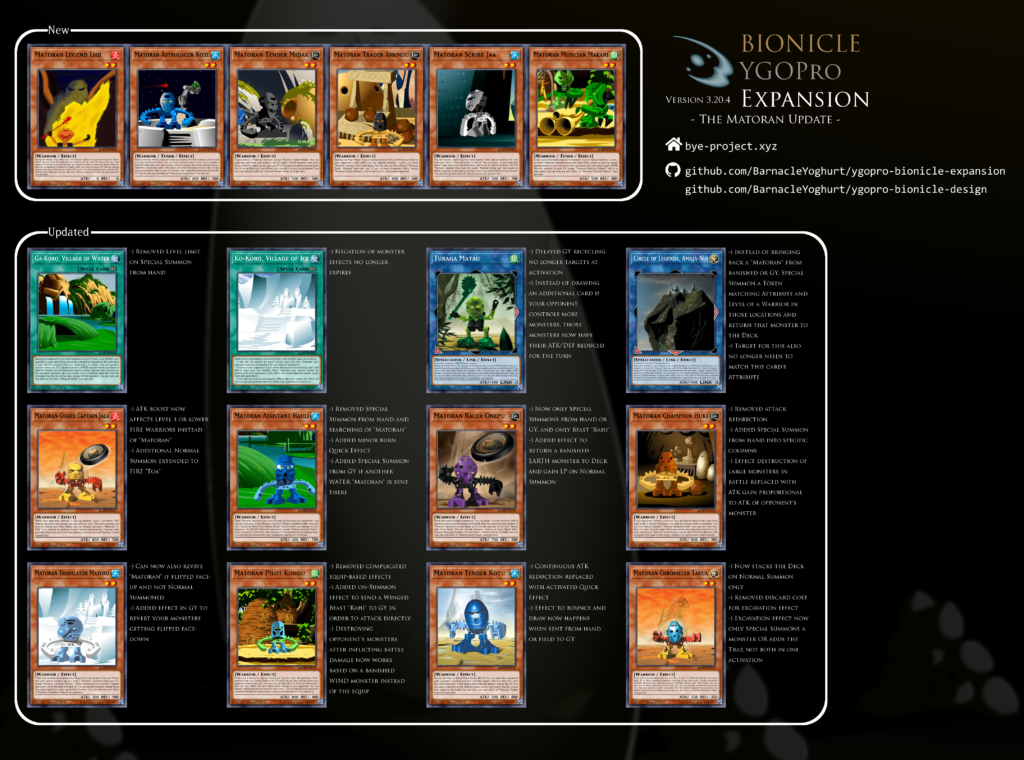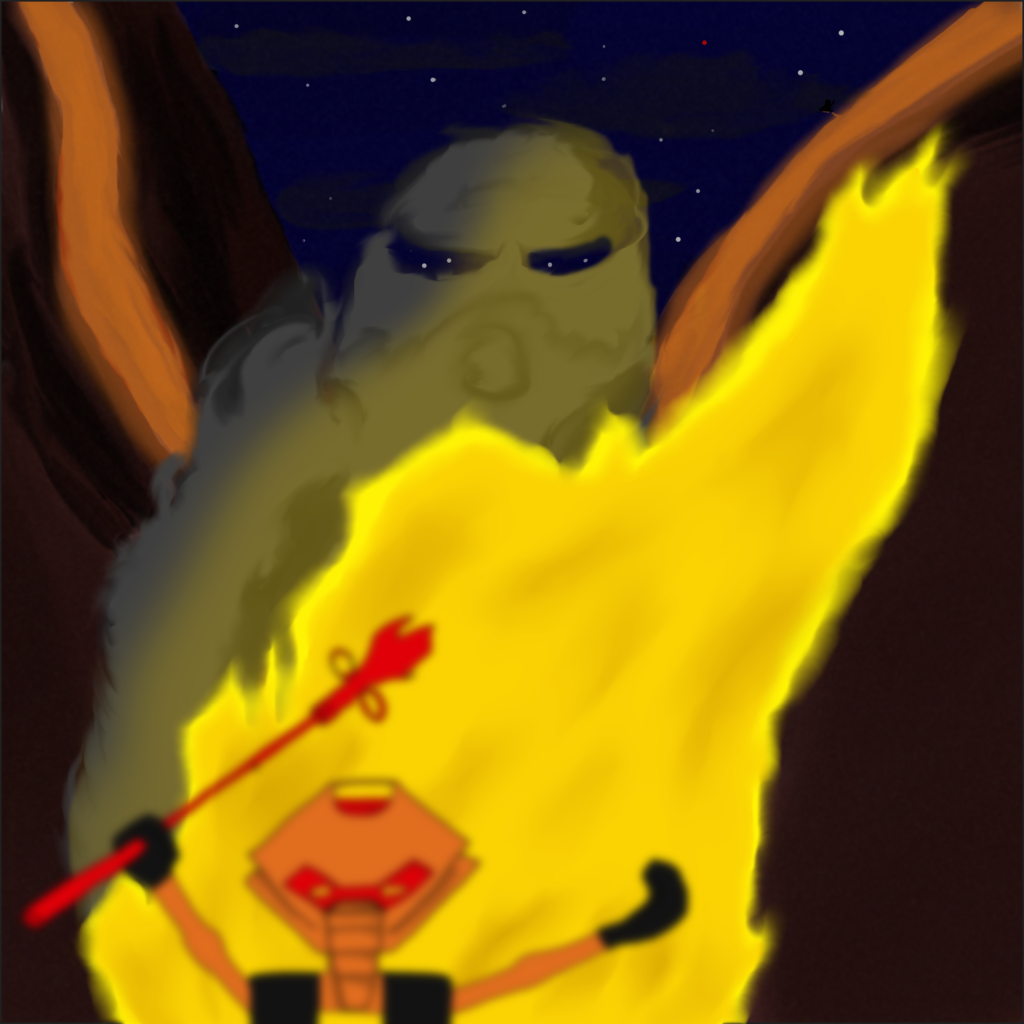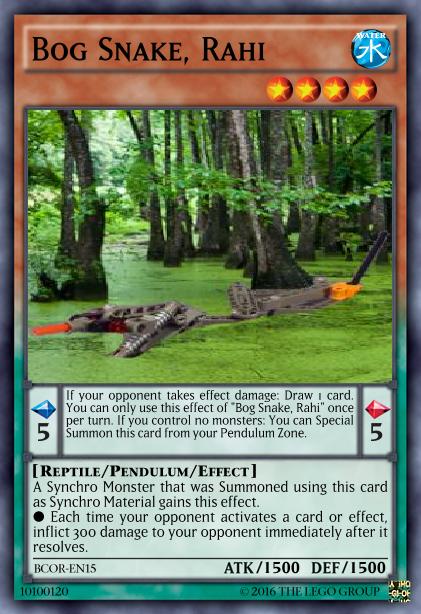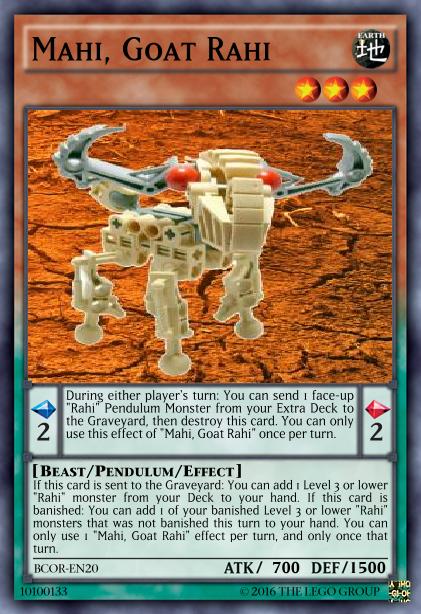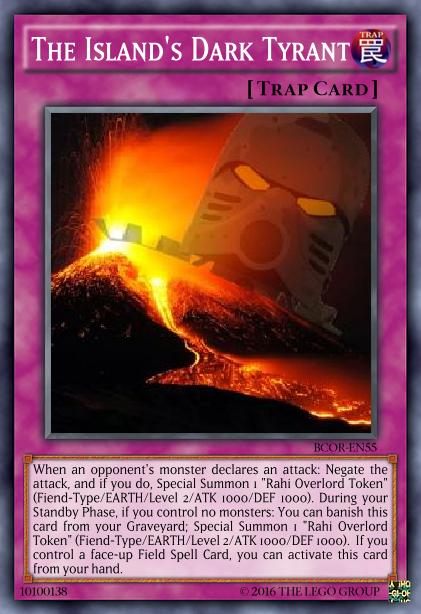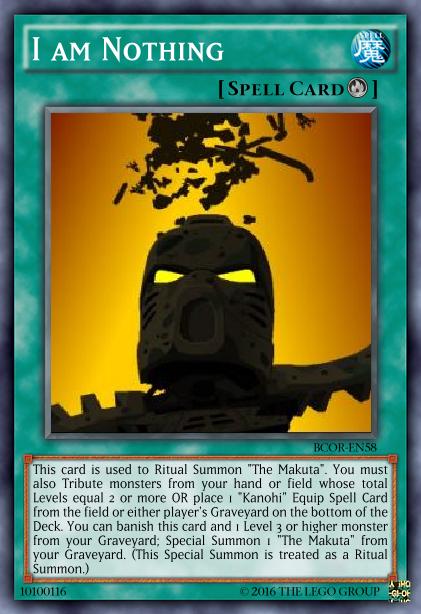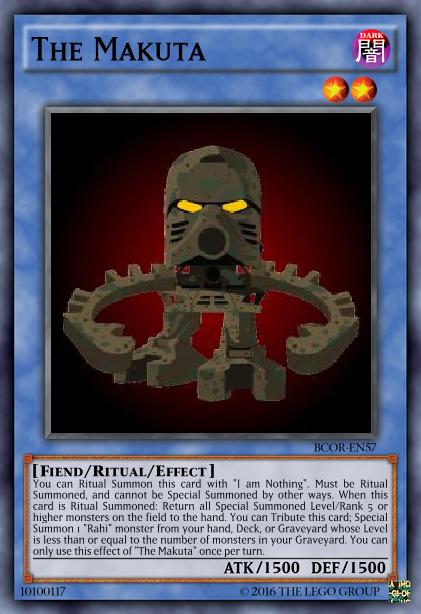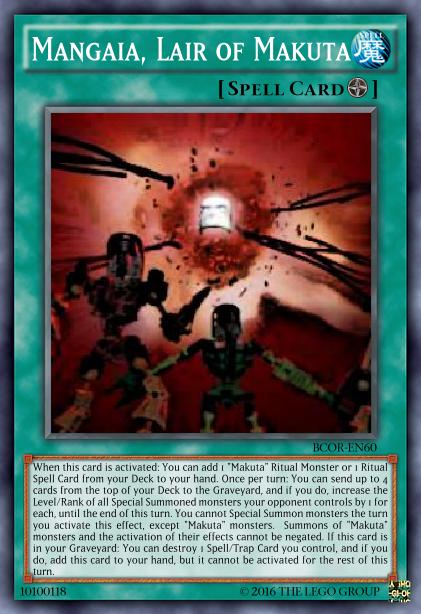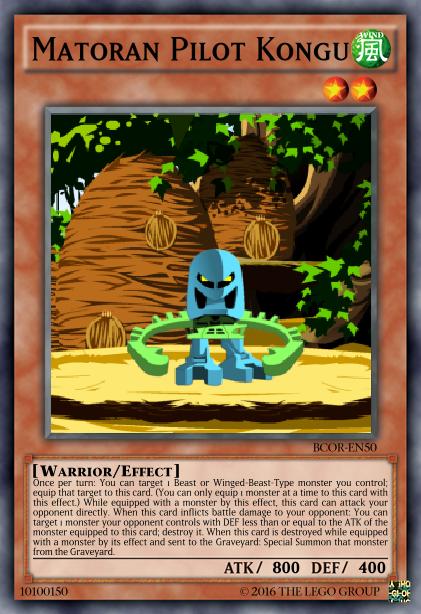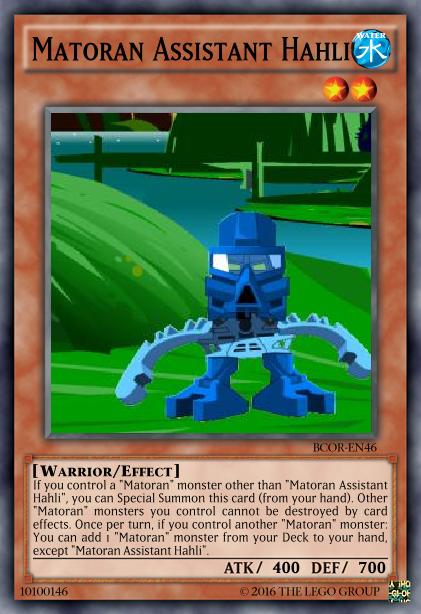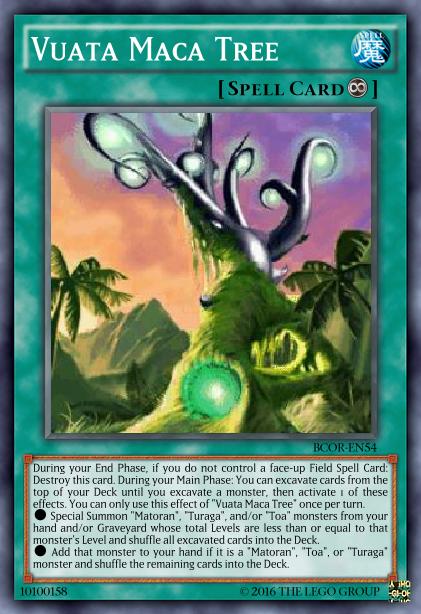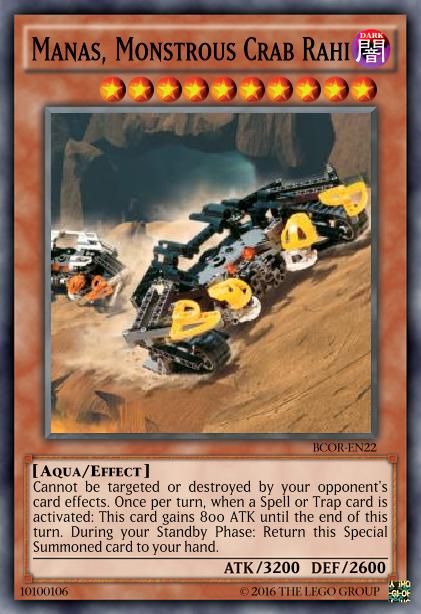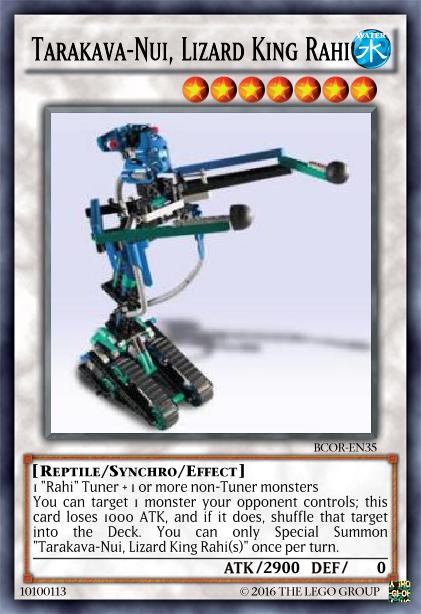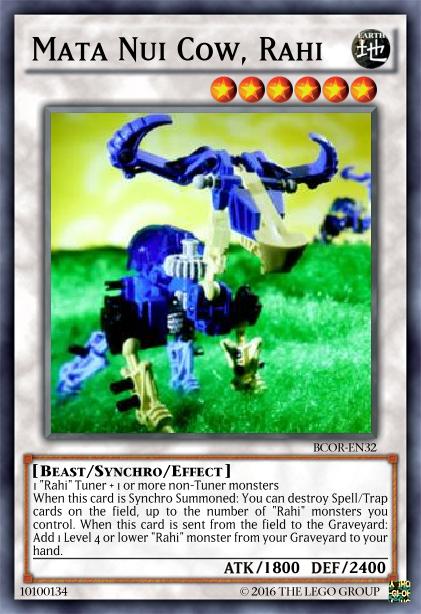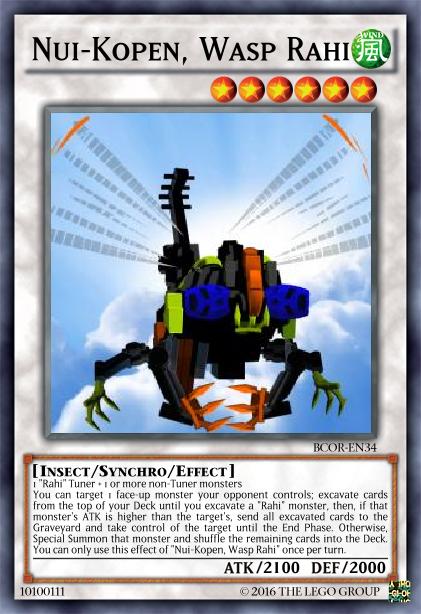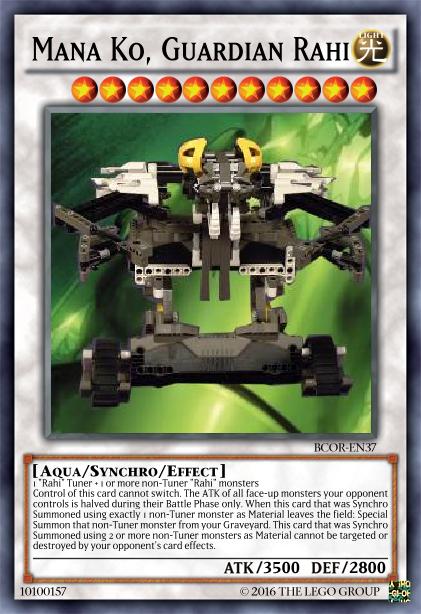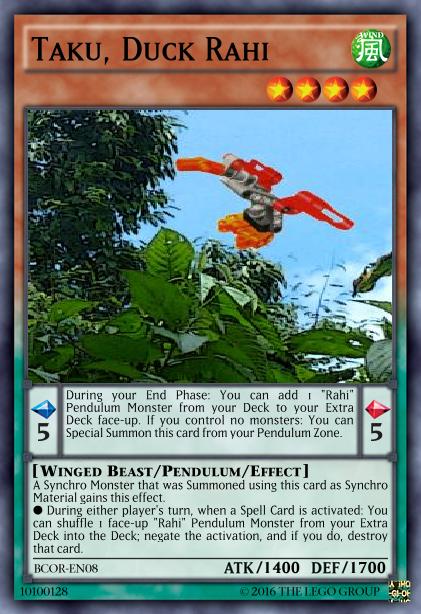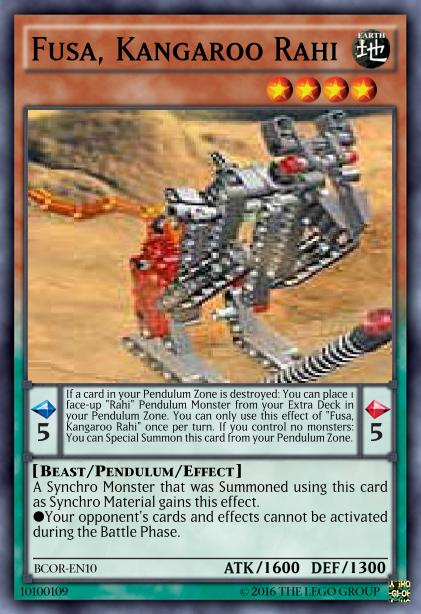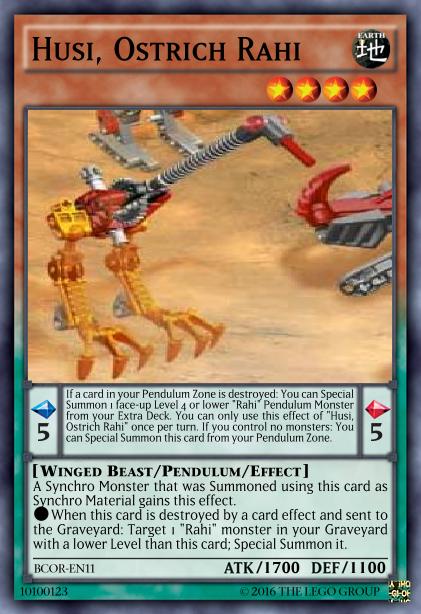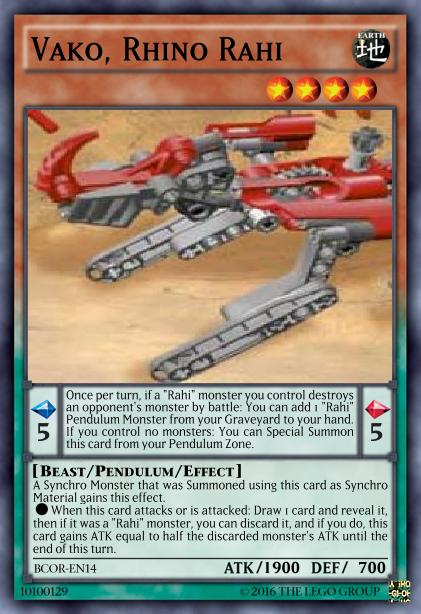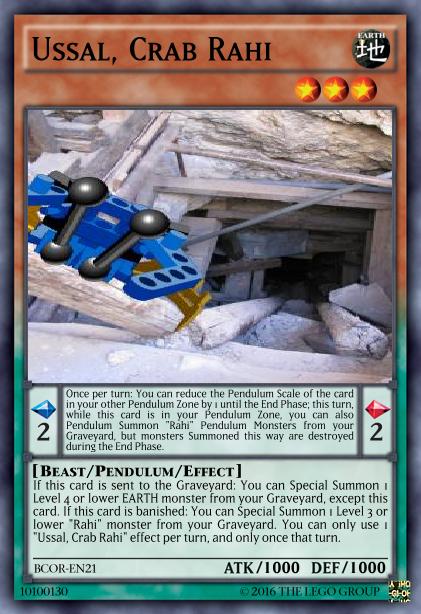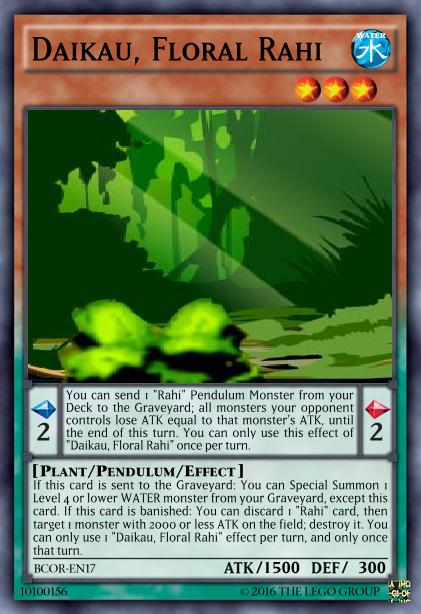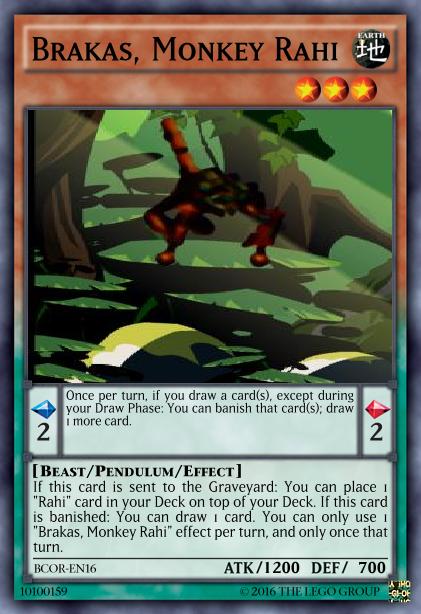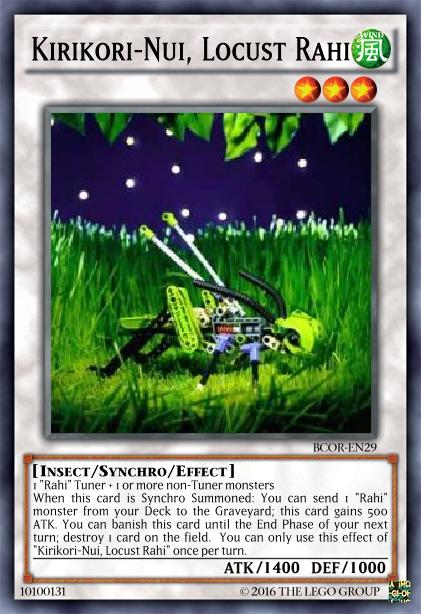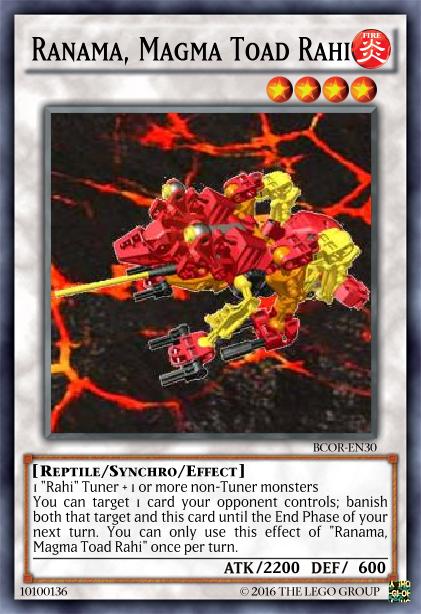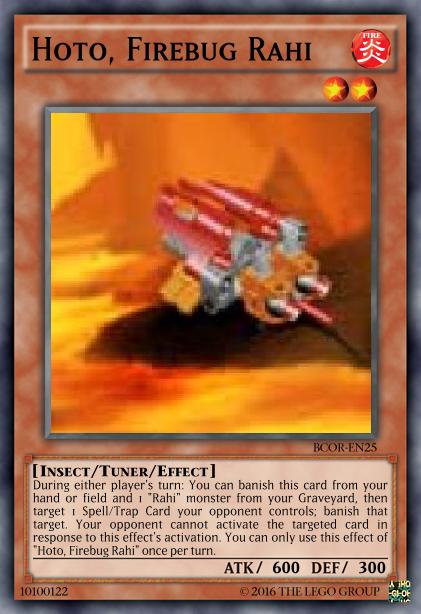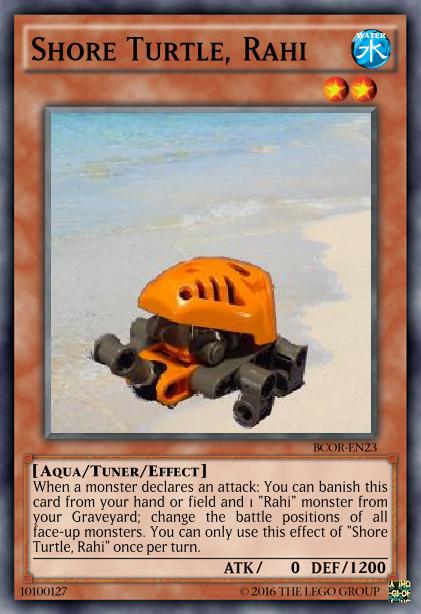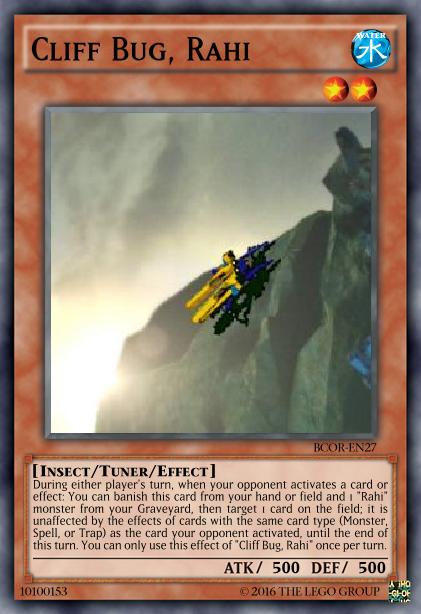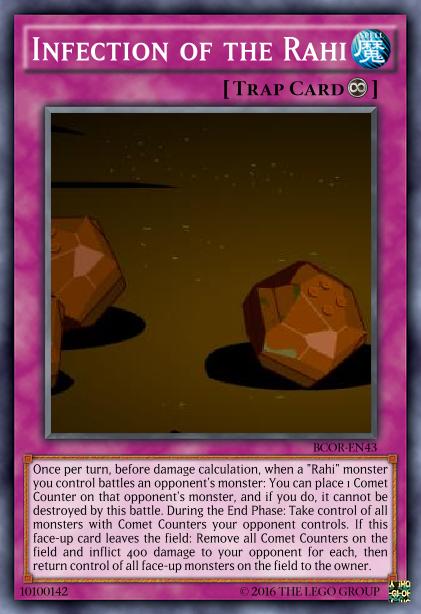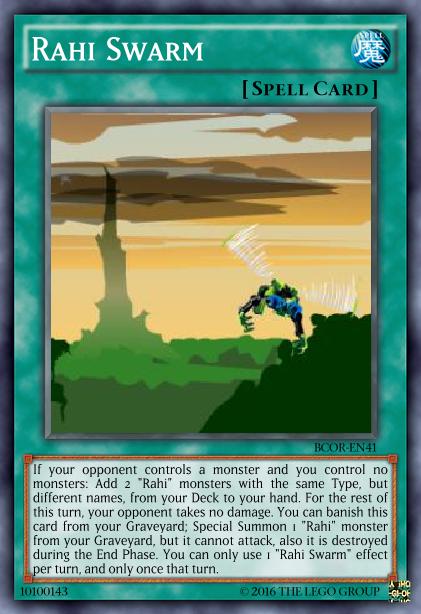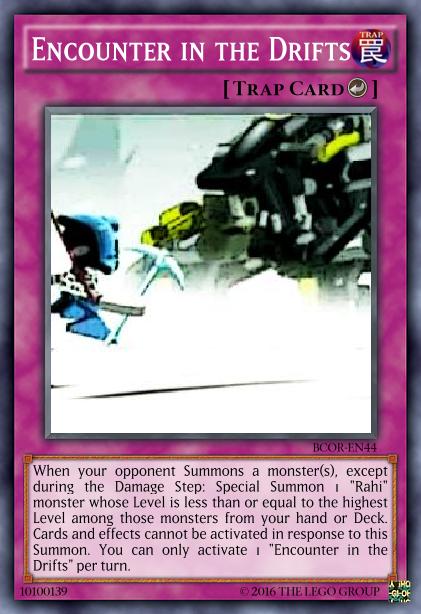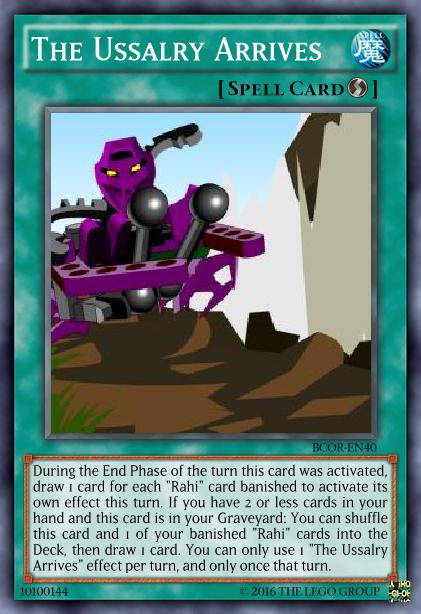Yep, it’s a big one. Just as foretold in the ancient prophecies of the roadmap, this month was focused on giving the Koro strategies I’ve been building up throughout the BCOT overhaul some more material to work with. One half of that was making the older Matoran from BCOR and BBTS align with their respective village’s newly established gameplan, and the other was introducing actually new cards representing Matoran of varying irrelevancy. This was a lot to get done in not a lot of days and as a result testing was a bit more minimal for these, so if you see something that looks blatantly broken, definitely speak up because there’s a good chance you’re right.
Rather than the usual release note structure of New / Updated, I think it makes more sense to go village by village here and investigate how each deck is impacted by its new options. At some point I’ll also have to update the old theme guides with that information, but for now let’s just put it here.
General
First of all, we should get the two tweaks with a more global impact out of the way.
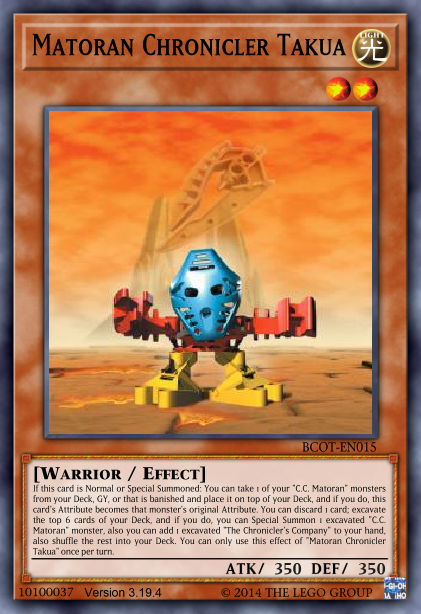
Matoran Chronicler Takua
Effect MonsterLevel 2 | LIGHT Warrior | ATK 350 / DEF 350If this card is Normal or Special Summoned: You can take 1 of your “C.C. Matoran” monsters from your Deck, GY, or that is banished and place it on top of your Deck, and if you do, this card’s Attribute becomes that monster’s original Attribute. You can discard 1 card; excavate the top 6 cards of your Deck, and if you do, you can Special Summon 1 excavated “C.C. Matoran” monster, also you can add 1 excavated “The Chronicler’s Company” to your hand, also shuffle the rest into your Deck. You can only use this effect of “Matoran Chronicler Takua” once per turn.

Matoran Chronicler Takua
Effect MonsterLevel 2 | LIGHT Warrior | ATK 350 / DEF 350If this card is Normal Summoned: You can take 1 of your “C.C. Matoran” monsters from your Deck, GY, or that is banished and place it on top of your Deck, and if you do, this card’s Attribute becomes that monster’s original Attribute. During your Main Phase: You can excavate the top 6 cards of your Deck, and if you do, you can Special Summon 1 excavated “C.C. Matoran” monster or add 1 excavated “The Chronicler’s Company” to your hand, also shuffle the rest into your Deck. You can only use this effect of “Matoran Chronicler Takua” once per turn.
Takua now only does the convenient setup for getting a C.C. Matoran from the Deck when he is Normal Summoned, which means you’re in gambling territory if you Special Summon him using Isolde, for example. However, after implementing this and testing, it became apparent that outside a deck filled to the brim with Chronicler’s Company members, the discard cost before excavating was never worth paying given the tiny chance of actually finding anything. So away went the discard, and along with that, the option to add “The Chronicler’s Company” (the archetypal Trap Card) was transformed from a lucky bonus to an alternative. Otherwise you’d be looking at a potential +2, which probably isn’t too healthy of a design.
With this change, Takua seems to perform well both in various Koro decks and in the main C.C. Matoran strategy. But he was also an essential component in the gimmicky Turaga Nui Turbo deck, and there, the inability to stack the deck and change his Attribute when Special Summoned actually does completely break one part of the combo. Thankfully, I was able to fix this issue by changing another card, Amaja-Nui, in a way that I think even improves it from a lore adaptation and balance standpoint.
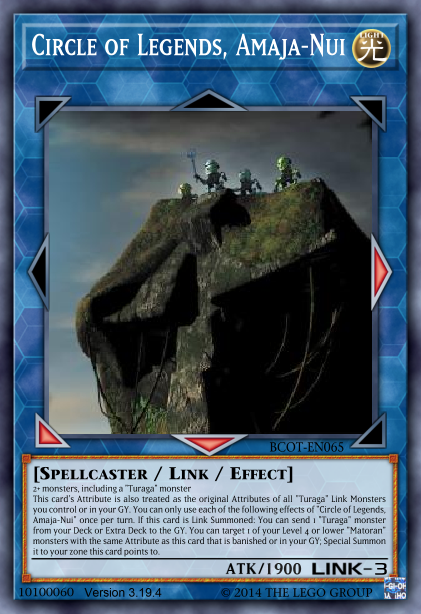
Circle of Legends, Amaja-Nui
Link Effect MonsterLink-3 [↙ ▼ ▶] | LIGHT Spellcaster | ATK 19002+ monsters, including a “Turaga” monster
This card’s Attribute is also treated as the original Attributes of all “Turaga” Link Monsters you control or in your GY. You can only use each of the following effects of “Circle of Legends, Amaja-Nui” once per turn. If this card is Link Summoned: You can send 1 “Turaga” monster from your Deck or Extra Deck to the GY. You can target 1 of your Level 4 or lower “Matoran” monsters with the same Attribute as this card that is banished or in your GY; Special Summon it to your zone this card points to.

Circle of Legends, Amaja-Nui
Link Effect MonsterLink-3 [↙ ▼ ▶] | LIGHT Spellcaster | ATK 19002+ monsters, including a “Turaga” monster
This card’s Attribute is also treated as the original Attributes of all “Turaga” Link Monsters you control or in your GY. You can only use each of the following effects of “Circle of Legends, Amaja-Nui” once per turn. If this card is Link Summoned: You can send 1 “Turaga” monster from your Deck or Extra Deck to the GY. You can target 1 of your Warrior monsters that is banished or in your GY; Special Summon 1 “Legend Stone Token” (Warrior/ATK 0/DEF 0) with the same Level and Attribute to your zone this card points to, then place that target on the top or bottom of the Deck.
The old version let you bring back a Matoran with the same Attribute as Amaja-Nui (meaning LIGHT or the Attribute of any Turaga you’ve used) as if calling them before the gathering of Turaga, which kind of fails to convey the core purpose of the location – telling stories and legends. On the other hand, the latest update changes this to creating a Token inheriting Level and Attribute of a spent Warrior monster, representing the stones within Amaja-Nui that were a key device in exactly this storytelling. The original monster is then placed on the top or bottom of the Deck, which is also important to recreating the combo that used to be possible with Takua.
Previously, what you would do is revive Takua with Amaja-Nui, stack Kapura on top of your Deck, and then use Takua (now FIRE) and another monster to make Vakama, who is then able to summon a FIRE Warrior from the top of your Deck and thus give you an extra body to continue the combo. Now, you instead directly target a FIRE Warrior with Amaja-Nui, place it on top of the Deck, and then use the Token you get to make Vakama for the same result. Only downside is you now need to get a FIRE Warrior banished or into the GY first, but that can be done pretty consistently by adopting Sublimation Knight as one of the starters in the deck.
Speaking of Kapura, he’s this month’s winner of the “should probably fix this but haven’t yet” prize. Specifically, in the final few test duels of the latest version, I noticed that letting any monster that survives a turn attack twice enables OTKs that just feel undeservedly sudden. Especially taking into account that the wording of the limitation as “not Summoned this turn” means something like a PSY-Framelord Omega coming back to your field after your opponent had no opportunity to interact with it at all is also a valid target.

C.C. Matoran Kapura
Effect MonsterLevel 2 | FIRE Warrior | ATK 600 / DEF 200If a “C.C. Matoran” monster you control attacks, your opponent’s cards and effects cannot be activated until the end of the Damage Step. At the start of your Battle Phase: You can banish this card from your GY, then target 1 face-up monster you control that was not Summoned this turn; it can make a second attack during this Battle Phase. You can only use this effect of “C.C. Matoran Kapura” once per turn.
The very simple solution I’m considering here is making that second attack on monsters only, which is a common restriction on effects of this type and greatly limits the potential damage output. In the Ta-Koro strategy itself, attacking monsters is what you want to do anyway, so it shouldn’t make any problems there.
Ta-Koro
The unga bunga strategy of Ta-Koro, a simple beatdown that hopes to OTK and benefits from destroying monsters in battle, receives an updated version of the captain of the guard himself as their first new asset.

Matoran Guard Captain Jaller
Effect MonsterLevel 2 | FIRE Warrior | ATK 800 / DEF 500While your opponent controls a face-up monster, “Matoran” monsters you control gain 400 ATK for each “Matoran” monster you control. During your Main Phase, you can Normal Summon 1 “Matoran” monster in addition to your Normal Summon/Set. (You can only gain this effect once per turn) You can only control 1 face-up “Matoran Guard Captain Jaller”.
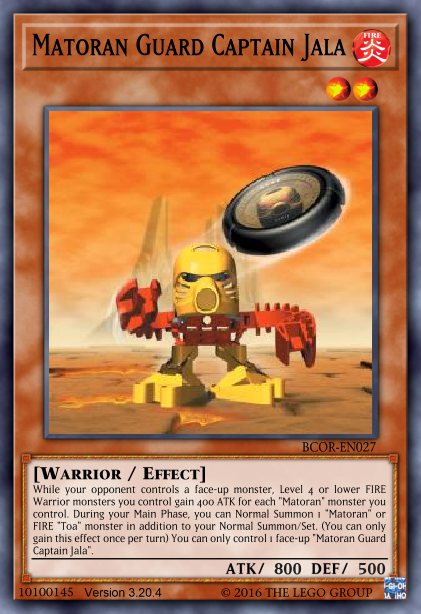
Matoran Guard Captain Jala
Effect MonsterLevel 2 | FIRE Warrior | ATK 800 / DEF 500While your opponent controls a face-up monster, Level 4 or lower FIRE Warrior monsters you control gain 400 ATK for each “Matoran” monster you control. During your Main Phase, you can Normal Summon 1 “Matoran” or FIRE “Toa” monster in addition to your Normal Summon/Set. (You can only gain this effect once per turn) You can only control 1 face-up “Matoran Guard Captain Jala”.
Where Jala previously buffed all other Matoran, that same buff is now applied to all your FIRE Warrior monsters up to Level 4, so it also affects the Tokens Vakama creates when his effect misses. And the additional Normal Summon can now be spent on not only Matoran, but also a FIRE Toa, which at this point means exactly Tahu. This part of the design I’m not terribly happy with, because it feels extremely forced and out of line with the other Matoran who do not directly reference the Toa (after all, they were fighting without them for a thousand years). The reason it’s in here for the time being anyway is that Tahu’s effect to both lower ATK and inflict burn damage upon battle destruction is extremely helpful when it comes to pulling off an OTK, but you also don’t really have the spare Normal Summon to get him out in the same turn you set up all your other stuff. If I eventually figure out a way to get around this without an ugly crutch, Jala is presumably going to change accordingly.
Moving on, this village’s contribution to the lineup of fresh Matoran is perhaps the most irrelevant of them all: Lhii, the legendary lava surfer.
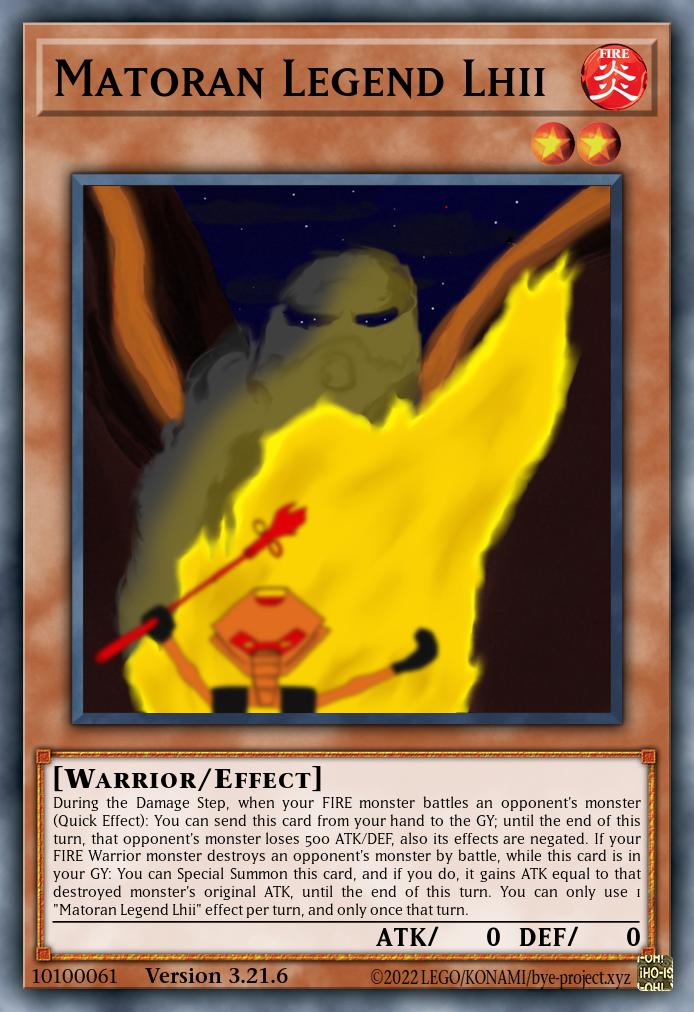
Matoran Legend Lhii
Effect MonsterLevel 2 | FIRE Warrior | ATK 0 / DEF 0During the Damage Step, when your FIRE monster battles an opponent’s monster (Quick Effect): You can send this card from your hand to the GY; until the end of this turn, that opponent’s monster loses 500 ATK/DEF, also its effects are negated. If your FIRE Warrior monster destroys an opponent’s monster by battle, while this card is in your GY: You can Special Summon this card, and if you do, it gains ATK equal to that destroyed monster’s original ATK, until the end of this turn. You can only use 1 “Matoran Legend Lhii” effect per turn, and only once that turn.
This entirely fictional (as in, more fictional than the rest of the story) individual was only found as a brief mention in some sections of the website in the early years, and only much later properly established to be a legend told in memory of the deceased Toa Lhikan. What this translates to is a 0 ATK/DEF monster (because he is not, in fact, real) that supports the residents of Ta-Koro by acting as a handtrap enabling destruction by battle where it would normally not have been possible, and by returning from the grave as a source of additional damage to close out games. These effects were chosen mostly because they were useful to the deck, but the fun thing is that I could potentially come back and reference them when I eventually implement the actual Lhikan, thus creating a solid piece of L O R E from absolutely nothing.
Another downside of Lhii being such an absolute background detail is that there wasn’t any official depiction of him, so rather than go look for fanart and having to deal with nuisances such as “permissions” and “credit”, I just went and made my own – a task only slightly complicated by not actually possessing the ability to draw. Praise be unto Krita and its wide array of brushes that can be spammed randomly until the image looks kinda decent.
The simple concept here is to show the Legend of Lhii being told through fire and smoke, with the fire being the lavaboard and the smoke the rest of the body. Hope that’s recognizable at least. From what I’ve found, there’s also the idea that Lhii is supposed to wear a Kanohi Pakari floating around, but that doesn’t seem to be backed by very solid evidence, so I went with the more obvious approach of giving the Matoran based on a Hau-wearing Toa a Hau.
… Did you notice the lava surfer in the background?
Ga-Koro
For Ga-Koro’s signature playstyle that involves a lot of both defensive and offensive actions on the opponent’s turn, we have Hahli as the updated BCOR Matoran.

Matoran Assistant Hahli
Effect MonsterLevel 2 | WATER Warrior | ATK 400 / DEF 700If you control a “Matoran” monster other than “Matoran Assistant Hahli”, you can Special Summon this card (from your hand). Other “Matoran” monsters you control cannot be destroyed by card effects. Once per turn, if you control another “Matoran” monster: You can add 1 “Matoran” monster from your Deck to your hand, except “Matoran Assistant Hahli”.
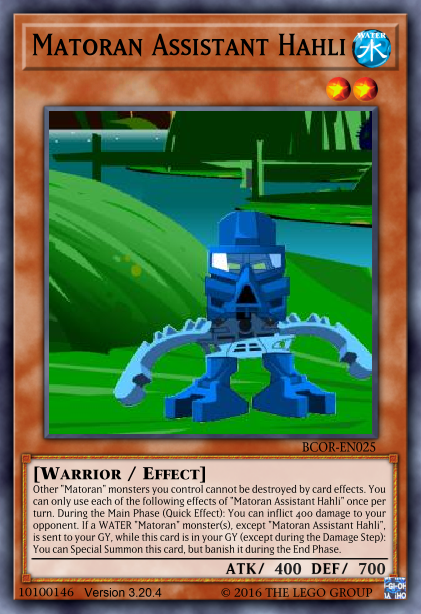
Matoran Assistant Hahli
Effect MonsterLevel 2 | WATER Warrior | ATK 400 / DEF 700Other “Matoran” monsters you control cannot be destroyed by card effects. You can only use each of the following effects of “Matoran Assistant Hahli” once per turn. During the Main Phase (Quick Effect): You can inflict 400 damage to your opponent. If a WATER “Matoran” monster(s), except “Matoran Assistant Hahli”, is sent to your GY, while this card is in your GY (except during the Damage Step): You can Special Summon this card, but banish it during the End Phase.
Unchanged is the destruction protection granted to other Matoran, but the rest of the card, a combination of a non-OPT Special Summon from hand and soft OPT Matoran search, was frankly broken as hell and needed to go. In it’s place comes a Quick Effect that does nothing but inflict a little bit of damage, reflecting the basic, yet helpful chores Hahli had to do in her position as assistant flax maker. The purpose of this is really just letting you easily get to Chain Link 2 on the opponent’s turn (the threshold where Ga-Koro makes all your effects unrespondable), so the amount of damage might even need to be lowered a bit. The other thing new Hahli has to offer is the ability to Special Summon herself from the GY when another WATER Matoran goes there, for example via being discarded for Nokama’s cost. Effects that trigger when sent from the hand or field to the GY are, to give a little spoiler, a staple of Ga-Matoran, so by having this trigger at the same timing, Hahli can once again “assist” in building Chain Links. I think it might make sense to have this effect happen during the opponent’s turn only so you can’t easily dodge the EP banish and instead need to recycle with Nokama, but the extra setup tool felt kinda important during testing, so for now it’s staying like this.
Before we get to the new face, there’s also a Matoran from BBTS that has received an update this time.

Matoran Tender Kotu
Effect MonsterLevel 2 | WATER Warrior | ATK 300 / DEF 800The monster(s) your opponent controls with the highest original ATK loses 800 ATK during the Battle Phase only. If this card is Normal Summoned: You can target 1 monster on the field; its owner draws 1 card, and if they do, return that target to the hand. You can only use this effect of “Matoran Tender Kotu” once per turn.
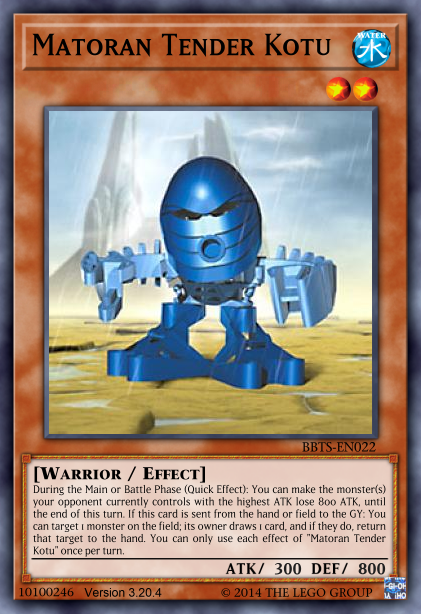
Matoran Tender Kotu
Effect MonsterLevel 2 | WATER Warrior | ATK 300 / DEF 800During the Main or Battle Phase (Quick Effect): You can make the monster(s) your opponent currently controls with the highest ATK lose 800 ATK, until the end of this turn. If this card is sent from the hand or field to the GY: You can target 1 monster on the field; its owner draws 1 card, and if they do, return that target to the hand. You can only use each effect of “Matoran Tender Kotu” once per turn.
Kotu only got very slight changes to her mechanics so they align better with the deck – reducing the opponent’s largest monster by 800 ATK is now an activated Quick Effect for dem Chain Links, and her previous effect on Normal Summon is now one of those effects that trigger when sent to the GY. Otherwise, it still does the same.
New to the crew is Ga-Koro’s astrologer Nixie.
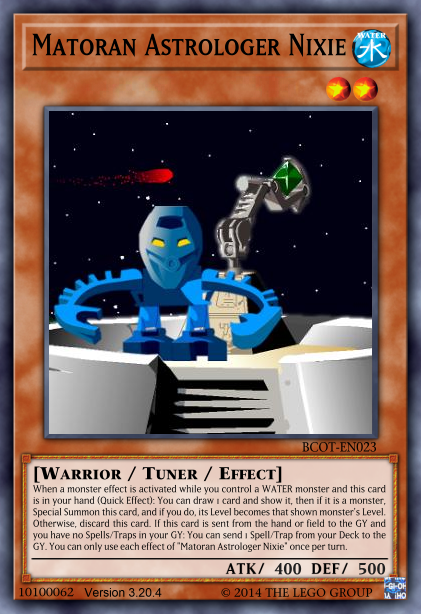
Matoran Astrologer Nixie
Tuner Effect MonsterLevel 2 | WATER Warrior | ATK 400 / DEF 500When a monster effect is activated while you control a WATER monster and this card is in your hand (Quick Effect): You can draw 1 card and show it, then if it is a monster, Special Summon this card, and if you do, its Level becomes that shown monster’s Level. Otherwise, discard this card. If this card is sent from the hand or field to the GY and you have no Spells/Traps in your GY: You can send 1 Spell/Trap from your Deck to the GY. You can only use each effect of “Matoran Astrologer Nixie” once per turn.
As her job involves observing the stars, I wanted to do something with Level manipulation, and since Ga-Koro tends to use Synchros, that went well with making her a tuner. The effects are once again a pair of a Quick Effect – this time triggering from the hand – and a trigger effect when sent from hand or field to the GY. The former makes you draw a card, check its Level (or “observe its stars” if you will), and Special Summon Nixe with the same Level, or discard her if it’s not a monster (though you still get to keep the card). The latter simply puts a Spell/Trap in a GY that doesn’t have them, to help set up Nokama’s protection.
Final tweak is on Ga-Koro itself, and simply consists of lifting the Level limit on WATER monsters you can Special Summon from your hand.

Ga-Koro, Village of Water
Field SpellDuring your opponent’s turn, if all monsters in your GY (min. 1) are WATER, your opponent’s cards and effects cannot be activated in response to the activation of your WATER monster effects as Chain Link 2 or higher. You can banish 1 monster from your GY; Special Summon 1 Level 4 or lower WATER monster from your hand in Defense Position, but its effects are negated and its Type becomes the same as the banished monster’s, also you cannot Special Summon monsters from the Extra Deck for the rest of this turn, except WATER monsters. You can only use this effect of “Ga-Koro, Village of Water” once per turn.

Ga-Koro, Village of Water
Field SpellDuring your opponent’s turn, if all monsters in your GY (min. 1) are WATER, your opponent’s cards and effects cannot be activated in response to the activation of your WATER monster effects as Chain Link 2 or higher. You can banish 1 monster from your GY; Special Summon 1 WATER monster from your hand in Defense Position, but its effects are negated and its Type becomes the same as the banished monster’s, also you cannot Special Summon monsters from the Extra Deck for the rest of this turn, except WATER monsters. You can only use this effect of “Ga-Koro, Village of Water” once per turn.
There are already several official cards that can do the same thing, so it’s pretty safe to say it doesn’t enable degenerate bullshit, and this way you can more easily make powerful Synchros worth protecting with Nokama.
Onu-Koro
The key feature of Onu-Koro is its ability to constantly replenish your resources, and this release supplements that with a nice little resource loop facilitated by an adjusted Onepu, the Ussal from the Rahi archetype, and the newly added Midak.
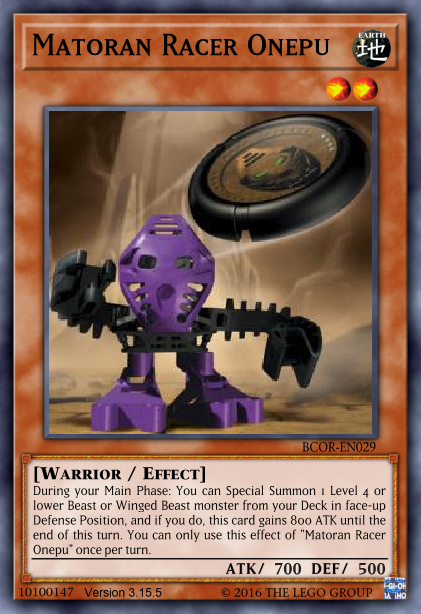
Matoran Racer Onepu
Effect MonsterLevel 2 | EARTH Warrior | ATK 700 / DEF 500During your Main Phase: You can Special Summon 1 Level 4 or lower Beast or Winged Beast monster from your Deck in face-up Defense Position, and if you do, this card gains 800 ATK until the end of this turn. You can only use this effect of “Matoran Racer Onepu” once per turn.

Matoran Racer Onepu
Effect MonsterLevel 2 | EARTH Warrior | ATK 700 / DEF 500When this card is Normal Summoned: You can target 1 of your banished EARTH monsters; place it on the bottom of the Deck, then you can reveal any number of “Matoran” monsters in your hand, and if you do, gain 500 LP for each. During your Main Phase: You can Special Summon 1 Level 4 or lower Beast “Rahi” monster from your hand or GY, but banish it when it leaves the field. You can only use each effect of “Matoran Racer Onepu” once per turn.
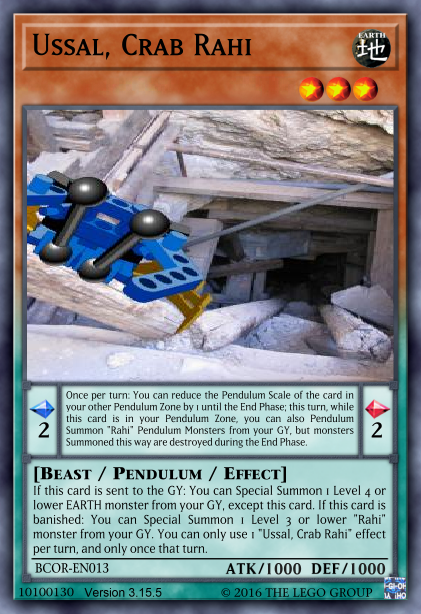
Ussal, Crab Rahi
Pendulum Effect MonsterLevel 3 | Scale 2/2 | EARTH Beast | ATK 1000 / DEF 1000Pendulum Scale = 2
[ Pendulum Effect ]
Once per turn: You can reduce the Pendulum Scale of the card in your other Pendulum Zone by 1 until the End Phase; this turn, while this card is in your Pendulum Zone, you can also Pendulum Summon “Rahi” Pendulum Monsters from your GY, but monsters Summoned this way are destroyed during the End Phase.
—————————————-
[ Monster Effect ]
If this card is sent to the GY: You can Special Summon 1 Level 4 or lower EARTH monster from your GY, except this card. If this card is banished: You can Special Summon 1 Level 3 or lower “Rahi” monster from your GY. You can only use 1 “Ussal, Crab Rahi” effect per turn, and only once that turn.

Matoran Tender Midak
Effect MonsterLevel 2 | EARTH Warrior | ATK 500 / DEF 500If you control a “Matoran” monster, except “Matoran Tender Midak”: You can send this card from your hand to the GY; send 1 EARTH monster from your Deck to the GY, and if you do, gain 400 LP. If this card would be returned from the GY to the Deck by a card effect, you can add it to your hand instead. You can only use each effect of “Matoran Tender Midak” once per turn.
To walk you through the play quickly: Putting Onepu on the field fulfills the condition to activate Midak in your hand, sending him and an Ussal from your Deck to the GY and being rewarded with 400 LP because he did his job as an Ussal handler. This will trigger the Ussal to bring back another EARTH monster from your GY, such as Midak. Furthermore, Onepu’s effect allows him to bring out the Ussal from the GY as well (and not from the Deck like in the old version, that was pretty stupid), and suddenly you have three whole monsters on the field. After using them all as material for something, Onepu and Midak will be in the GY where Onu-Koro can put them back into your Deck so they’re ready to go again, except Midak will avoid the darkness of the Deck and instead claim a bright spot in your hand – he’s not the Midak Skyblaster’s namesake for nothing. Meanwhile, the Ussal remains banished, but if you can just manage to find Onepu again, his other effect allows you to recycle that as well, with a bonus of gaining an LP reward depending on how many Matoran are in attendance to be awed by the tales of the great Ussal Racer’s achievments. And at this point, you might have noticed, you’re at the exact point where the combo started and can do it all over again.
Po-Koro
Po-Koro follows the tried-and-true principle of Special Summoning a bunch of monsters and using them as fodder to bring out bosses from the Extra Deck via various mechanics. Their new support helps with this in what I find to be interesting ways, starting with Huki.
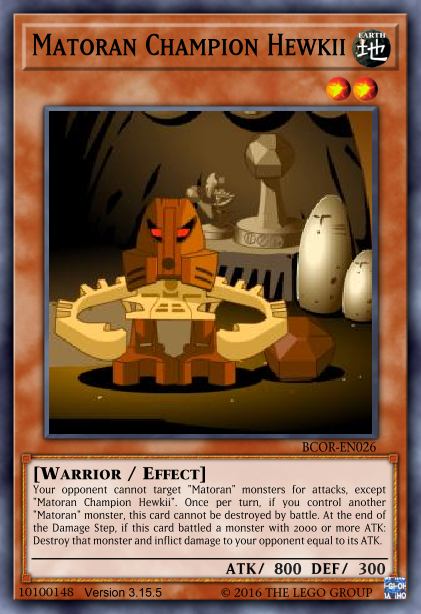
Matoran Champion Hewkii
Effect MonsterLevel 2 | EARTH Warrior | ATK 800 / DEF 300Your opponent cannot target “Matoran” monsters for attacks, except “Matoran Champion Hewkii”. Once per turn, if you control another “Matoran” monster, this card cannot be destroyed by battle. At the end of the Damage Step, if this card battled a monster with 2000 or more ATK: Destroy that monster and inflict damage to your opponent equal to its ATK.

Matoran Champion Huki
Effect MonsterLevel 2 | EARTH Warrior | ATK 800 / DEF 300If your opponent controls a monster, you can Special Summon this card (from your hand) in Attack Position to your zone in a column with no monsters. You can only Special Summon “Matoran Champion Huki” once per turn this way. Once per turn: You can target 1 face-up monster your opponent controls in the same column as a “Matoran” monster you control; until the end of this turn, this card gains ATK equal to that target’s current ATK, but it cannot attack directly.
Special Summoning from the hand with some funny column shenanigans obviously helps you combo, especially if you manage to hit a zone Onewa points to (thus triggering further Special Summons). Meanwhile, the ATK boosting effect is a more balanced replacement for the old version’s crazy blowout effect when battling powerful monsters. I think I may have even overbalanced it by making its activation condition stand at odds with the Special Summon condition, but who knows.
And to be entirely honest, a lot of this effect was designed to interact specifically with Maku and thus recreate the most classic ship from a world where love is not canon. I even made a little video to illustrate.
I know, I’m a comedic genius.
Anyway, there’s another Po-Matoran to talk about, and among the new additions he stands out as easily the most plot-relevant one. It is none other than the prolific traitor trader Ahkmou.

Matoran Trader Ahkmou
Effect MonsterLevel 2 | EARTH Warrior | ATK 400 / DEF 600During your Main Phase: You can Special Summon this card from your hand to your opponent’s field, and if you do, Special Summon 1 Level 4 or lower “Matoran” monster from your hand. You can only use this effect of “Matoran Trader Ahkmou” once per turn. If you activate a monster effect, except “Matoran Trader Ahkmou”: Give control of this card to your opponent.
The trade deal offered by this trustworthy merchant involves placing him on the opponent’s field in exchange for bringing out one of your Matoran from the hand, but he will in fact change sides at the drop of a hat, or rather at the activation of a monster effect. What this does in practical terms is putting a monster on your opponent’s field going first, turning off certain interruptions like Infinite Impermanence or Gamma and softening the blow of others by giving you an additional monster to work with once the chain resolves. Just make sure you don’t accidentally lose his allegiance again before you can use him. Oh, and Ahkmou can enable Huki’s inherent Special Summon turn 1, which is also pretty cool.
Ko-Koro
For the stall strategy of Ko-Koro, the new release provides more ways to get yourself the advantage in field presence you need to keep the game locked down until you win. As the BCOR updatee (is that a word?), we have Matoro, Nuju’s translator.
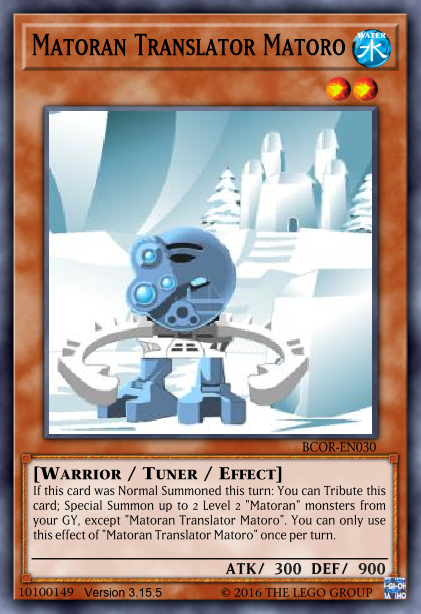
Matoran Translator Matoro
Tuner Effect MonsterLevel 2 | WATER Warrior | ATK 300 / DEF 900If this card was Normal Summoned this turn: You can Tribute this card; Special Summon up to 2 Level 2 “Matoran” monsters from your GY, except “Matoran Translator Matoro”. You can only use this effect of “Matoran Translator Matoro” once per turn.

Matoran Translator Matoro
Effect MonsterLevel 2 | WATER Warrior | ATK 300 / DEF 900If this card was Normal Summoned or flipped face-up this turn: You can Tribute this card; Special Summon up to 2 Level 2 “Matoran” monsters from your GY, except “Matoran Translator Matoro”. When a monster(s) you control is flipped face-down, while this card is in your GY: You can banish this card; change those face-down monsters to face-up Defense Position. You can only use each effect of “Matoran Translator Matoro” once per turn.
His original ability to revive others by Tributing himself (based on, well, the obvious) remains pretty much unchanged, with the only difference being that it now also works if he was flipped face-up that turn, since Nuju flips your own monsters to clear the opponent’s field. This leads us straight to the second effect, which replaces the Tuner designation as the representation of his job as translator. Because if the monsters being flipped face-down is meant to be Nuju confusing his allies by speaking in bird language, then obviously Matoro clearing up the confusion would simply revert the flip.
In the new slot, we have Jaa, one of the scribes in charge of writing down Wall of Prophecy translations. Where did those prophecies even come from? Honestly I’m not sure, but it probably also doesn’t matter.
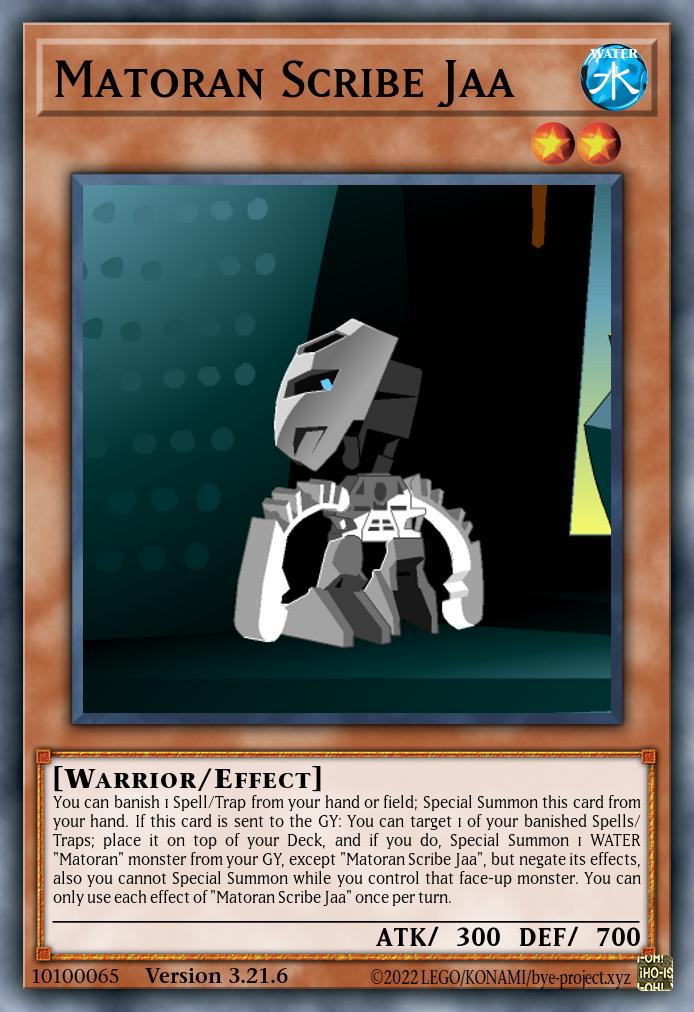
Matoran Scribe Jaa
Effect MonsterLevel 2 | WATER Warrior | ATK 300 / DEF 700You can banish 1 Spell/Trap from your hand or field; Special Summon this card from your hand. If this card is sent to the GY: You can target 1 of your banished Spells/Traps; place it on top of your Deck, and if you do, Special Summon 1 WATER “Matoran” monster from your GY, except “Matoran Scribe Jaa”, but negate its effects, also you cannot Special Summon while you control that face-up monster. You can only use each effect of “Matoran Scribe Jaa” once per turn.
Jaa takes advantage of the large amount of Spells and Traps you run in a Ko-Koro deck (since you don’t want to use monster effects on the opponent’s turn) and uses them as fodder to put himself on the field, making him a useful on-Attribute search target for Kopeke. Later, when he hits the GY, he can put the card banished for his Summon back on top of the Deck (as if writing down a prophecy of your next draw) and simultaneously bring out another WATER Matoran from the GY. With the tiny drawback of getting locked out of all Special Summons. Which you can turn off by simply flipping the monster face-down to bounce something with Nuju. I think you get the idea. Do note that the Special Summon is mandatory, so activating the effect to get back a banished card may bite you in the ass – an intentional flaw to make sure he isn’t quite so easy to use as a generic Spell/Trap recycler.
Ko-Koro also got one little update to patch a somewhat fatal flaw. While it previously only negated the effects of your opponent’s Special Summoned monsters for a single turn, this negation is now permanent – as long as the other conditions of only controlling WATER monsters and not having activated monster effects that turn are fulfilled, of course.

Ko-Koro, Village of Ice
Field SpellWhile all face-up monsters you control (min. 1) are WATER, apply these effects.
●If you did not declare an attack during your last turn, monsters your opponent controls cannot attack the turn they are Summoned.
●If none of your opponent’s cards where destroyed or banished by your card effects since your last Standby Phase, monsters you control cannot be destroyed by your opponent’s card effects, also your opponent cannot target them with card effects.
●If you did not activate any monster effects this turn, negate the effects of face-up monsters that were Special Summoned this turn while your opponent controls them.
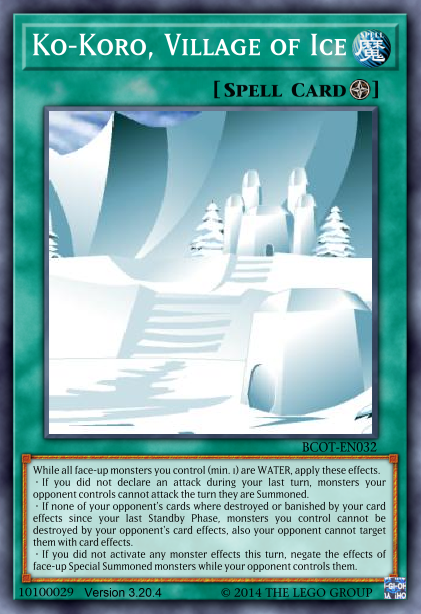
Ko-Koro, Village of Ice
Field SpellWhile all face-up monsters you control (min. 1) are WATER, apply these effects.
●If you did not declare an attack during your last turn, monsters your opponent controls cannot attack the turn they are Summoned.
●If none of your opponent’s cards where destroyed or banished by your card effects since your last Standby Phase, monsters you control cannot be destroyed by your opponent’s card effects, also your opponent cannot target them with card effects.
●If you did not activate any monster effects this turn, negate the effects of face-up Special Summoned monsters while your opponent controls them.
This way you aren’t totally helpless against opponents who can bring out a monster during your End Phase or something like that, and I figure it’s still not all that terribly oppressive and unfun as far as lockdowns go, since you need to keep actively removing monsters anyway if you want to keep yourself safe from battle as well.
Le-Koro
Most important to Le-Koro is the ability to recover and rebuild starting from minimal resources, and the first new piece of support for this is another Matoran/Rahi combo in the form of Kongu and the Kewa.
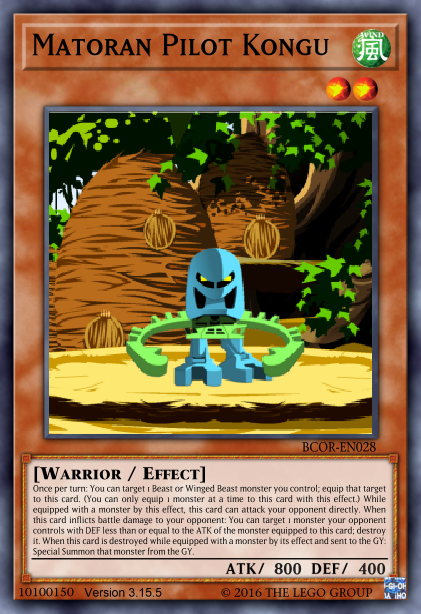
Matoran Pilot Kongu
Effect MonsterLevel 2 | WIND Warrior | ATK 800 / DEF 400Once per turn: You can target 1 Beast or Winged Beast monster you control; equip that target to this card. (You can only equip 1 monster at a time to this card with this effect.) While equipped with a monster by this effect, this card can attack your opponent directly. When this card inflicts battle damage to your opponent: You can target 1 monster your opponent controls with DEF less than or equal to the ATK of the monster equipped to this card; destroy it. When this card is destroyed while equipped with a monster by its effect and sent to the GY: Special Summon that monster from the GY.

Matoran Pilot Kongu
Effect MonsterLevel 2 | WIND Warrior | ATK 800 / DEF 400If this card is Normal or Special Summoned: You can send 1 Winged Beast “Rahi” monster from your hand or Deck to the GY, and if you do, this card can attack your opponent directly this turn. You can only use this effect of “Matoran Pilot Kongu” once per turn. When this card inflicts battle damage to your opponent: You can banish 1 WIND monster from your GY, then target 1 face-up monster your opponent controls with DEF less than or equal to that banished monster’s ATK; destroy it.
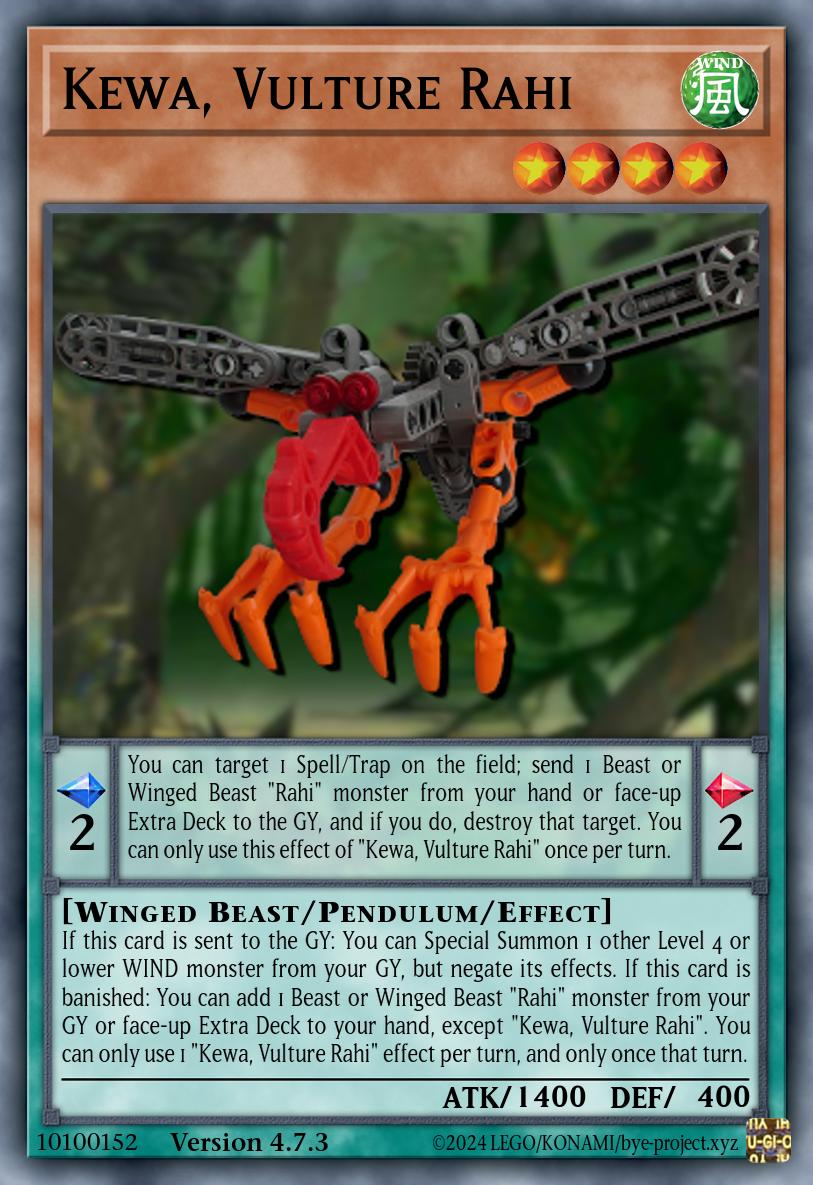
Kewa, Vulture Rahi
Pendulum Effect MonsterLevel 4 | Scale 2/2 | WIND Winged Beast | ATK 1400 / DEF 400[ Pendulum Effect ]
You can target 1 Spell/Trap on the field; send 1 Beast or Winged Beast “Rahi” monster from your hand or face-up Extra Deck to the GY, and if you do, destroy that target. You can only use this effect of “Kewa, Vulture Rahi” once per turn.
—————————————-
[ Monster Effect ]
If this card is sent to the GY: You can Special Summon 1 other Level 4 or lower WIND monster from your GY, but negate its effects. If this card is banished: You can add 1 Beast or Winged Beast “Rahi” monster from your GY or face-up Extra Deck to your hand, except “Kewa, Vulture Rahi”. You can only use 1 “Kewa, Vulture Rahi” effect per turn, and only once that turn.
Replacing super gimmicky and overly complicated equip shenanigans is something that may feel familiar from the Onu-Koro section. Indeed, the Kewa is the same type of Rahi as the Ussal, and provides the same service when sent to the GY, just for WIND monsters. Kongu, meanwhile, is the way to get the birb there, symbolically allowing him to fly over the enemy lines and attack directly. Which you may not use if you’re instead using him and the monster revied by the Kewa as material, but if you do, there’s also the additional utility of destroying monsters with sufficiently low DEF after inflicting battle damage.
The final new card of the release is Makani, whom you may know from the famous Le-Koro Band. Or from the Elementsaber archetype. Turns out naming a wind guy after the Hawaiian word for “wind” isn’t the most unique idea.
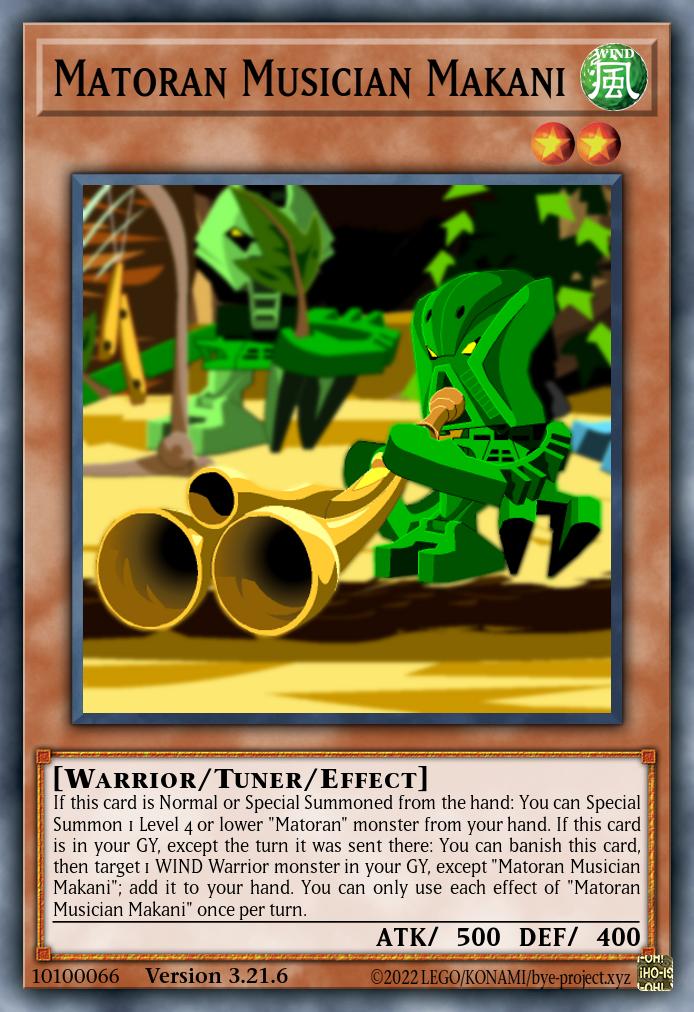
Matoran Musician Makani
Tuner Effect MonsterLevel 2 | WIND Warrior | ATK 500 / DEF 400If this card is Normal or Special Summoned from the hand: You can Special Summon 1 Level 4 or lower “Matoran” monster from your hand. If this card is in your GY, except the turn it was sent there: You can banish this card, then target 1 WIND Warrior monster in your GY, except “Matoran Musician Makani”; add it to your hand. You can only use each effect of “Matoran Musician Makani” once per turn.
Aside from being a Tuner (because music), Makani provides a very simple pair of effects: Bring out another Matoran on Summon – regardless of Attribute, since he plays music to welcome travellers as well – and recycling a WIND Warrior in your GY on later turns. This, as it turns out, is a much more potent combination than I had anticipated, and in testing Makani seriously feels like one of the most useful Matoran cards to date. Not sure if it’s actually to the point of requiring some kind of nerf, but he’s certainly good.
Something I should point out is that both Kongu and Makani having effects that trigger when they are Summoned reflects an important design element for Le-Koro, since it lets you chain them to the Field Spell’s search effect and get value before the negate from that hits.
Last but not least, the second effect of Matau received some changes.

Turaga Matau
Link Effect MonsterLink-2 [↙ ▶] | WIND Spellcaster | ATK 14002 monsters, including a WIND Warrior monster
During your Main Phase: You can Special Summon 1 Level 4 or lower WIND monster from your hand in Attack Position, but its ATK becomes 0. If this card is sent from the field to the GY: You can target 1 other WIND monster in your GY; during the Standby Phase of your next turn, add that target to your hand, then, if your opponent controls more monsters than you do, draw 1 card. You can only use each effect of “Turaga Matau” once per turn.
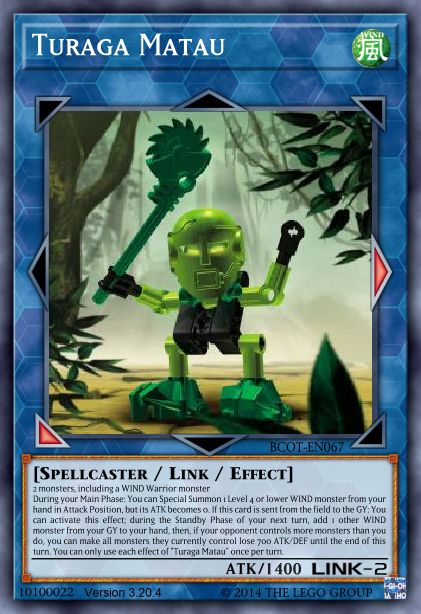
Turaga Matau
Link Effect MonsterLink-2 [↙ ▶] | WIND Spellcaster | ATK 14002 monsters, including a WIND Warrior monster
During your Main Phase: You can Special Summon 1 Level 4 or lower WIND monster from your hand in Attack Position, but its ATK becomes 0. If this card is sent from the field to the GY: You can activate this effect; during the Standby Phase of your next turn, add 1 other WIND monster from your GY to your hand, then, if your opponent controls more monsters than you do, you can make all monsters they currently control lose 700 ATK/DEF until the end of this turn. You can only use each effect of “Turaga Matau” once per turn.
One thing is that it doesn’t target the monster to get back during the next Standby Phase at activation anymore, mostly because EDOPro didn’t really make that easy to keep track of. Instead you get to choose when it resolves, which I think might pose some issues with the requirement of “other WIND monster” (since Matau may have left and returned to the GY in the meantime) – if so, I’ll probably either remove the other or strengthen it to “except Matau”. The other change is that the bonus draw in case your opponent controls more monsters was replaced with a temporary ATK/DEF reduction for your opponent’s field, potentially making the board easier to break when you make your comeback. I think this is better because it incorporates the prankster aspect of Matau, and now you can get an extra card to your hand by simply having Makani in GY anyway.
This was long and I am very sorry for that. Respect to you if you actually read it all.

